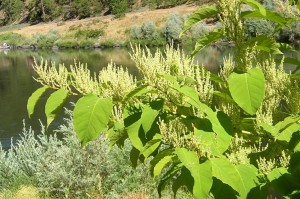Polygonum cuspidatum
Japanese and giant knotweed were introduced as ornamentals to North America in the 1800s and soon escaped to become weedy. These tall, fast-growing herbaceous perennials are also known as false bamboo, due to their similar appearance. The knotweeds thrive in moist areas and are highly invasive along streams and rivers.
Japanese and giant knotweed thrives in a variety of habitats, but is most prolific in moist areas. They invade stream banks, roadside ditches, and waste areas. In riparian environments, knotweed can dominate and displace native plants and lead to streambank erosion. The plants die back each winter, leaving bare exposed soils that can enter waterways, impacting water quality.
For more information on controlling Japanese knotweed on your property, check out this King County Best Management Practice resource.
